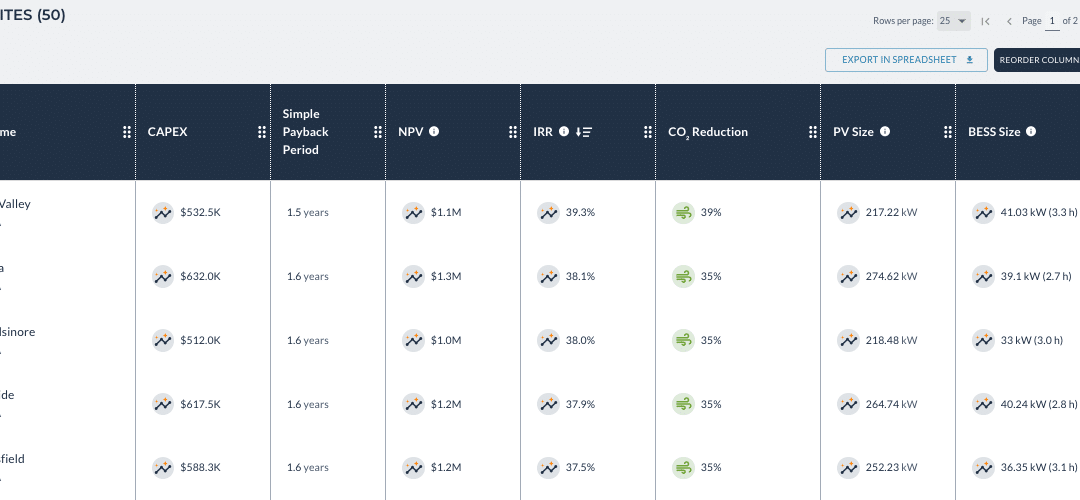Deploying onsite energy systems across a large portfolio of sites is an immensely complex undertaking. So much so that doing it successfully at scale as eluded most companies. Each site has location-specific characteristics, such as utility rates, energy consumption, environmental factors, permitting constraints and incentives that change randomly.
However, considering a portfolio in its entirety is critical to ensuring the most economic projects are built and a company is following a lucrative onsite energy strategy. On the flip side, companies are less likely to invest in sub-optimal projects unknowingly. Contrary to the common inclination to start with the largest energy-consuming facilities, there might be another site with more positive leaning levers that make it a better investment.
The energy market’s inherent dynamic nature requires businesses to adapt to changes that might transform a project’s viability over time. Factors such as fluctuating fuel costs, evolving incentives, and shifting tariff structures can dramatically alter the landscape within short periods. Hence, a project that may not initially appear lucrative could, in due course, become highly viable as market conditions evolve. Embracing this fluidity and preparing to pivot when opportunities arise underscores the importance of continuous monitoring and reassessment in strategic energy management.
In this article, we’ll review the core factors that contribute to whether a project pencils, why assessing an entire portfolio is an essential part of setting a successful onsite energy strategy, and how to approach it in a way that benefits the entire organization. This is part of our Pain Points series from VECKTA’s podcast Renewable Rides. Listen to the related episode on portfolio-level assessments here.
Energy Rates
In nearly all areas of the country, utilities hiked up rates last year more than ever before, with some reaching up to the 50 percent range. Energy rates, including both energy and demand charges, represent a critical factor in the financial viability of energy projects. These rates are subject to variation across different locations, and their future trajectory can significantly impact the planning and budgeting processes for energy management. Businesses need to closely monitor how these rates are expected to evolve, reflecting on how load growth—unevenly distributed across regions—will affect energy costs.
Renewable Energy Potential
The potential for renewable energy generation varies widely with geographical location. Factors such as solar irradiance and wind patterns play a pivotal role in determining the suitability and efficiency of renewable energy projects in specific regions. By assessing the local renewable resources available, organizations can tailor their energy solutions to harness the most abundant and cost-effective sources.
Resiliency
Evaluating the historical and projected risk of power outages in an area allows for proactive measures to ensure energy reliability and infrastructure resilience. Industries with processes sensitive to power interruptions, like semiconductor manufacturing, may face significant operational and financial setbacks from unplanned outages. And for other industries that gain competitive advantage by staying open during outages – like retail centers and gas stations – should be thinking about the costs associated with outages. Consequently, understanding and planning for these contingencies is paramount.
Site Consumption Patterns
The diversity in the energy consumption patterns, geographic location, and operational needs of each facility within a portfolio means that no one-size-fits-all solution can be applied. This necessitates a tailored approach to determining the most suitable energy solutions for each site.
Incentives
Government incentives, such as the Inflation Reduction Act, California’s SGIP program and REAP grants for rural projects, have a profound effect on improving the financial aspects of energy projects. Staying informed about the eligibility criteria and application processes for these incentives can transform projects from marginally viable to financially attractive propositions. The difficulty lies in the fact that incentives do shift and there are different incentives on so many levels including federal, state, county, city, town, utility areas, low-income areas, rural, and wildfire zones. Even sites that are within the same county can be subject to different incentives and different utility constraints.
Space and Technology Constraints
Physical constraints, including available space for renewable installations or energy storage, as well as accessibility to gas connections or other infrastructure, can significantly impact the feasibility and design of energy projects. Additionally, an in-depth assessment of the costs and labor requirements associated with deploying specific energy technologies is critical for informed decision-making.
A Tech-First Approach to Deploying Onsite Energy
When managing a vast portfolio of sites, addressing each site’s local concerns through traditional means like spreadsheets becomes untenable. Instead, leveraging advanced analytical tools and platforms like VECKTA can provide the comprehensive insights needed to tailor energy strategies effectively. By focusing on these localized concerns, organizations can significantly enhance the efficiency, sustainability, and resilience of their energy management strategies.
The agility to respond to a changing market, coupled with a strategic focus on maximizing returns from energy projects, lays the groundwork for building a resilient and future-proof strategy. By prioritizing projects that offer the greatest financial, environmental, and operational benefits, businesses can create a self-reinforcing loop of investment and improvement. This process not only enhances immediate operational efficiency but also sets the stage for long-term sustainability and growth.
The key lies in the judicious allocation of resources, informed by reliable data and guided by clear strategic objectives, ensuring that every initiative taken is a step towards a more sustainable and resilient future.
In conclusion, the energy transition journey is underscored by the need for strategic prioritization, dynamic market adaptation, and the harnessing of technology to simplify data acquisition and analysis. As organizations navigate these challenges, the path to energy efficiency, sustainability, and resilience demands a nuanced understanding of the local context, informed by a wealth of data and guided by clear strategic vision.


